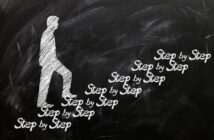This is a guest post written by Coby Bergman and reposted with the consent of the author. See author biography at the end of this article.
My mission in life is to live as happy and high-integrity a life as possible.
This mission guides how I am every minute of every day.
This article provides the step-by-step process I’m following to live as happy a life as possible (‘part 1’ of my mission). It will guide you through the happiness equation I use, and how I control the variables in that equation.
While maximizing happiness may or may not be your goal, I’m hopeful that this process is helpful regardless.
I know it’s been life-changing for me.
Introduction
I view happiness as a skill that I can hone through emotional intelligence.
With practice, I believe I’ll become so effective at being happy that I’ll be able to go the rest of my life and (almost) never again experience unhappiness.
I say ‘almost’ because I’m not sure whether perfection is really possible here. I treat the journey towards an unhappiness-free life like the journey of an asymptote – constantly getting closer to perfection but never quite attaining it.
That said, I’m not inventing the wheel here. I’m taking inspiration from Buddhism, stoicism, and people like Trevor Timbeck.
Also, I know that I’m approaching this journey from a position of immense privilege.
For example, I haven’t experienced severe trauma in my life, I don’t suffer from depression, and I have a loving and present community who are my support system. I also recognize that my privilege extends in countless directions beyond this – in more directions than I even know. All of this means my happiness journey is likely paved more smoothly than it might be for others.
Lastly, there’s an FAQ at the bottom of this article. If something isn’t resonating, check it out.
“If you wish to converse with me, define your terms.” – Voltaire
Emotional Intelligence:
The ability to measure and manage my emotions. E.g. to engage with any situation, no matter how challenging, from a place of happiness.
Happiness:
It’s hard to define precisely, but it’s the feeling you have when you’re content, calm, exuberant, proud, laughing gleefully, or enjoying the presence of a friend etc. Essentially, happiness is all the emotions you feel when unhappiness is absent.
Unhappiness:
It’s also tough to define, but it’s feelings of frustration, fear, resentment, unconstructive stress, unconstructive anger, being too hard on yourself, etc. Essentially, unhappiness is all the emotions you feel when happiness is absent.
Why was my emotional status quo unacceptable to me?
Here are a couple of the stories that kicked off my emotional intelligence journey 8 years ago. Perhaps parts of them will resonate with you.
If you prefer to jump to the details of the emotional intelligence process, skip this section.
Story 1
In 2014 I was trying to close a sale that would have allowed me to hit my sales target for the first time in my career. It was a big deal for me, and I had it all tee’d up. Then, it completely unraveled.
I found out it was falling apart around 11am and proceeded to spend the next 4 hours thought-spiraling. I didn’t get any work done. Over the next two weeks I was distracted and furious with myself for allowing the deal to slip through. I replayed my entire history with the account over and over in my head; thinking of all the moments where I should have approached things differently.
I felt crappy for a non-trivial proportion of those two weeks. It later occurred to me that I wanted to live as happy a life as possible, and yet happiness wasn’t something I had direct control over.
Story 2
Later in 2014 I had what I can only describe as a mental health breakdown. My mental health had deteriorated to the point where I felt I couldn’t say “hi” to someone in the hall without my face contorting into a sob. As the days passed, I started to wonder if I’d ever be able to have a conversation with someone without crying again.
I was scared.
Afterward, I recognized that the breakdown had been influenced by things that were in my control. In particular, it was caused by stress.
It was a terrible experience and I never wanted to experience anything like that again. I decided I was going to learn how to manage the inputs to my unhappiness.
My (Un)happiness Equation
Unhappiness = my expectations of my reality – my perception of my reality
When my perception of my reality doesn’t meet my expectations, I feel unhappy. When it meets or exceeds my expectations, I feel happy.
It’s that simple.
So when it comes to going the rest of my life and (almost)* never again experiencing unhappiness, the name of the game is to control the two variables at my disposal:
- My expectations
- My perceptions
To do that, I need to be able to measure and manage the performance of my two variables in two different ways:
- Proactively: The goal here is to reduce the likelihood and severity of future unhappiness
- Reactively: The goal here is to increase the speed and reliability with which I can transition out of unhappiness once I’ve been triggered. I consider myself triggered any time I enter fight, flight, or freeze mode.
How do I manage my expectations proactively?
I fine-tune my life priorities – aka what a successful life looks like for me.
- I developed a clear life mission – to live as happy and high-integrity a life as possible. Fulfilling that mission is my only goal in life.
- I’ve defined success as progress – I’m playing an infinite game.
- I chose priorities that I and only I can control.
- I continue to review and (if necessary) update my priorities annually. Interestingly, my approach to my mission has changed a bit over the years, but the spirit of it has stayed consistent for 8 years running.
How do I manage my perceptions proactively?
I treasure hunt – I’m continuously on the lookout for new perspectives.
- I have a mental utility belt that I fill with perspectives that help me navigate the world more effectively. I’m constantly searching for new perspectives to add to the collection, and old ones to discard that are no longer working for me.
- I map out shortcuts – places where I can (more) quickly and reliably uncover new perspectives.
- I prioritize perspectives that directly address the most common root causes of my unhappiness.
How do I manage my expectations and perceptions reactively? (it’s the same process for both)
- I can’t manage what I’m not measuring so step 1 is to practice spotting my triggers quickly. Over time, my ‘spotting time’ has decreased from weeks (essentially, not being self-aware enough to even realize that I’m triggered), to hours, to minutes, and over the past couple years to seconds (or less).
- Step 2 is rapid response – I immediately course-correct by swapping my unhelpful perspective for a more productive one from my toolkit. Most of the time, I can now do this in seconds or less.
- If I’m mid-conversation with someone and I’m unable to complete steps 1 and 2 within a few seconds, I signal to them that I’m not in a constructive headspace and need some space to step back and reflect.
- I then conduct a storytelling exercise.
- I open up a blank google doc in my ‘Personal Development’ google drive folder, create a table with two columns and lots of rows, title the left hand column ‘Current Story’ and the right hand column ‘More Productive Story’, and then fill in the story I’m currently telling myself.
- Each point in the story goes in a separate row, and each point that is connected in some way to my unhappiness gets a more productive ‘companion perspective’ in the right-hand column.
- When I review my current story, I consistently find that I’m making assumptions about how an event will impact my life mission. As with all assumptions in life, I treat these assumptions as suspect.
- I’m also making assumptions in the more productive story. The difference is those assumptions serve me better.
- I choose which story I’m going to adopt going forward.
- If I’m still struggling, I ask my network for help. For me, this is typically my wife, my coach, or a friend. Someone who I trust to help me shift my perspective.
How do I make the journey to an unhappiness-free life easy(er)?
- I invest in my support system.
- I keep in touch with friends
- I’m vulnerable with the people around me – if they don’t know what I’m experiencing they can’t help me or advocate for me.
- I ask my network for help with practicing the emotional intelligence techniques described in this article.
- I ask strangers for help – e.g. with challenging career situations. My network hasn’t always felt strong, but asking for help has increased the number of people who care about me and are invested in me.
- I mitigate the risk of ‘system shocks’, which are major life events that make it substantially harder to feel happy.
- This means I prioritize exercise, healthy eating, and sleep in order to decrease my risk of poor health.
- I manage my finances in a way that creates as much short and long term financial security as possible (e.g. emergency fund, life and disability insurance, etc.). When this isn’t feasible, the other tactics here take on greater importance.
- I reflect a lot on my own mortality and the mortality of the people closest to me, and read stories written by folks who’ve lost people they love – to learn about their experience and how they cope with that loss, and to level-set my own expectations.
This journey also gets easier the more privilege a person has, which means people will face varying degrees of challenge on their own personal journeys..
Conclusion
Living a life where I (almost) never again experience unhappiness will be a lifelong journey. I don’t know for sure that it’s even possible, but I’m committed to exploring the possibility.
I’ve been honing my emotional intelligence process for 8 years now. While I still occasionally feel frustrated, it’s much less frequent, and much less costly an experience than it has been in the past. I’m also becoming more adept at recognizing when I’m triggered and ‘nipping it in the bud’ – typically within seconds.
Prior to embarking on this journey, I had a reputation in my company for being ‘intense’. For the past couple years though, I’ve developed a reputation for being thoughtful, calm, and curious, and as someone who always engages constructively and professionally – no matter how challenging the circumstances.
When I look at my journey to-date, I see a promising trendline.
For these reasons, I see mastering emotional intelligence as one of the most impactful things I can do to live as happy and high-integrity a life as possible.
FAQ About My Playbook
Can’t these ‘unhappy’ emotions be positive, constructive forces?
Sometimes, emotions like stress and anger give people focus and energy. For example, I appreciate a certain level of healthy stress – stress I can turn on and off when I need to in order to focus and get something done. For me, these emotions only contribute to unhappiness when they’re non-constructive or unwanted.
Aren’t all emotions valid?
I believe all emotions are valid and neutral. While I view certain emotions as less desirable for me, I don’t think it’s bad when I feel them. I also recognize that approaching emotions this way doesn’t work well for everyone.
By treating some emotions as bad, doesn’t that set an expectation that feeling them is bad?
In my experience, and for me, it does. There have been moments in the past where I was frustrated that I was feeling frustrated – I would thought spiral and that thought spiral would impact my work and sleep. This is why I no longer think of unhappy emotions as bad. They’re just something I prefer to minimize, but I accept them while they’re here.
Does this approach to thinking about and managing emotions work for everyone?
As far as I can tell, it doesn’t. Many thoughtful and capable people don’t share my approach to managing emotions. There are countless ways to live a meaningful and happy life.
Final Comments
I hope that this article has inspired some new perspectives that you can add to your own mental utility belt.
If you decide to practice any of this – please send let me know how it goes. I’d love to hear about it.
Lastly, if you think anything is missing or needs adjusting in this process, please let me know in the comments. By no means is anything here ‘perfect’ (whatever that even means).
About The Author
 Coby Bergman is an experienced revenue leader with nearly a decade of experience leading and scaling revenue teams. He’s built his career by following his mission of building the most capable and engaged revenue teams, and does this by focusing on mastering the art of self-management. Coby’s strong focus on emotional intelligence, life-long learning, and his practice of continuous daily improvement have enabled him to be a thoughtful and dedicated leader who is truly focused on creating amazing teams. When he’s not working, he’s spending time with his wife and daughter, and likely planning or participating in an outdoor adventure.
Coby Bergman is an experienced revenue leader with nearly a decade of experience leading and scaling revenue teams. He’s built his career by following his mission of building the most capable and engaged revenue teams, and does this by focusing on mastering the art of self-management. Coby’s strong focus on emotional intelligence, life-long learning, and his practice of continuous daily improvement have enabled him to be a thoughtful and dedicated leader who is truly focused on creating amazing teams. When he’s not working, he’s spending time with his wife and daughter, and likely planning or participating in an outdoor adventure.




